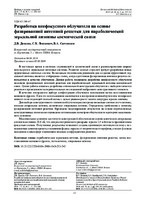| dc.contributor.author | Довкша, Д. В. | |
| dc.contributor.author | Лешкевич, С. В. | |
| dc.contributor.author | Саечников, В. А. | |
| dc.coverage.spatial | Минск | ru |
| dc.date.accessioned | 2019-09-16T12:01:06Z | |
| dc.date.available | 2019-09-16T12:01:06Z | |
| dc.date.issued | 2019 | |
| dc.identifier.citation | Довкша, Д. В. Разработка внефокусного облучателя на основе фазированной антенной решетки для параболической зеркальной антенны космической связи = Development of an out-of-Focus Irradiator Based on a Phased Antenna Array for a Space Communications' Parabolic Reflector Antenna / Д. В. Довкша, С. В. Лешкевич, В. А. Саечников // Приборы и методы измерений : научно-технический журнал. – 2019. – Т. 10, № 3. – С. 233-242. | ru |
| dc.identifier.uri | https://rep.bntu.by/handle/data/57093 | |
| dc.description.abstract | В настоящее время в системах спутниковой и космической связи и радиоастрономии широко используются зеркальные антенные системы. Развитие данных отраслей требует разработки новых эффективных антенных систем. Возможным техническим решением для создания эффективной зеркальной антенны является «гибридная» схема, когда адаптивная фазированная антенная решетка используется в качестве облучателя. Данная работа посвящена разработке внефокусного облучателя на основе фазированной антенной решетки для параболической зеркальной антенны космической связи. Целью работы являлась разработка оптимальной конструкции облучателя с выбором элемента решетки и проведением экспериментальных исследований выбранного конструктивного элемента. В качестве инструмента выбора конфигурации облучателя использован метод восстановления волнового фронта. Идея его использования заключается в воспроизведении облучателем электромагнитного поля падающей плоской волны с целью равномерного засвета апертуры зеркала антенны. Для выбора конструктивного элемента облучателя рассмотрены несколько антенн: патч-антенна, плоская спиральная антенна, коническая спиральная антенна. Определены требования к элементу фазированной антенной решетки. Проведено моделирование облучателя на основе перечисленных конструктивных элементов и проведена оптимизация геометрии облучателя по критерию максимального усиления. Максимальное усиление достигнуто конструкцией облучателя на основе конических спиральных антенн и составило 30,8 дБ, что для рассматриваемого раскрыва зеркала 2,4 м близко к традиционным фокусным схемам. Полученные результаты позволяют создать адаптивную антенную систему с возможностью компенсировать отклонения формы зеркала от теоретического профиля, а также фазовые искажения в атмосфере изменением весовых коэффициентов решетки. | ru |
| dc.language.iso | ru | ru |
| dc.publisher | БНТУ | ru |
| dc.title | Разработка внефокусного облучателя на основе фазированной антенной решетки для параболической зеркальной антенны космической связи | ru |
| dc.type | Article | ru |
| dc.identifier.doi | 10.21122/2220-9506-2019-10-3-233-242 | |
| local.description.annotation | Mirror antenna systems are widely used in satellite and space communication systems and radio astronomy. Development of these areas requires new efficient antenna systems' design. Possible technical solution for creating an effective mirror antenna is a “hybrid” scheme, when an adaptive phased antenna array is used as an irradiator. This paper is devoted to the development of an out-of-focus irradiator based on a phased antenna array for a space communications' parabolic reflector antenna. The aim of the work is to develop an optimal design of the irradiator with the choice of the structural element of the antenna array and experimental studies of the selected structural element. The wavefront recovery method was used as a tool for selecting the irradiator configuration. The idea of this method use is to reproduce the electromagnetic field of an incident plane wave with an irradiator in order to uniformly illuminate the aperture of the antenna mirror. In order to select the structural element of the irradiator several antennas were considered: a patch antenna, a flat spiral antenna, a conical spiral antenna. The requirements for the phased antenna array element were defined. The irradiator based on the above mentioned was simulated and the irradiator geometry was optimized according to the maximum gain criterion. The maximum gain was achieved for the irradiator based on conical spiral antennas and amounted to 30.8 dB, which for the considered mirror aperture of 2.4 m is close to traditional focal schemes. The results obtained make it possible to create an adaptive antenna system able to compensate for the deviations of the mirror's shape from the theoretical profile, as well as phase distortions in the atmosphere by changing the lattice weights coefficients. | ru |

